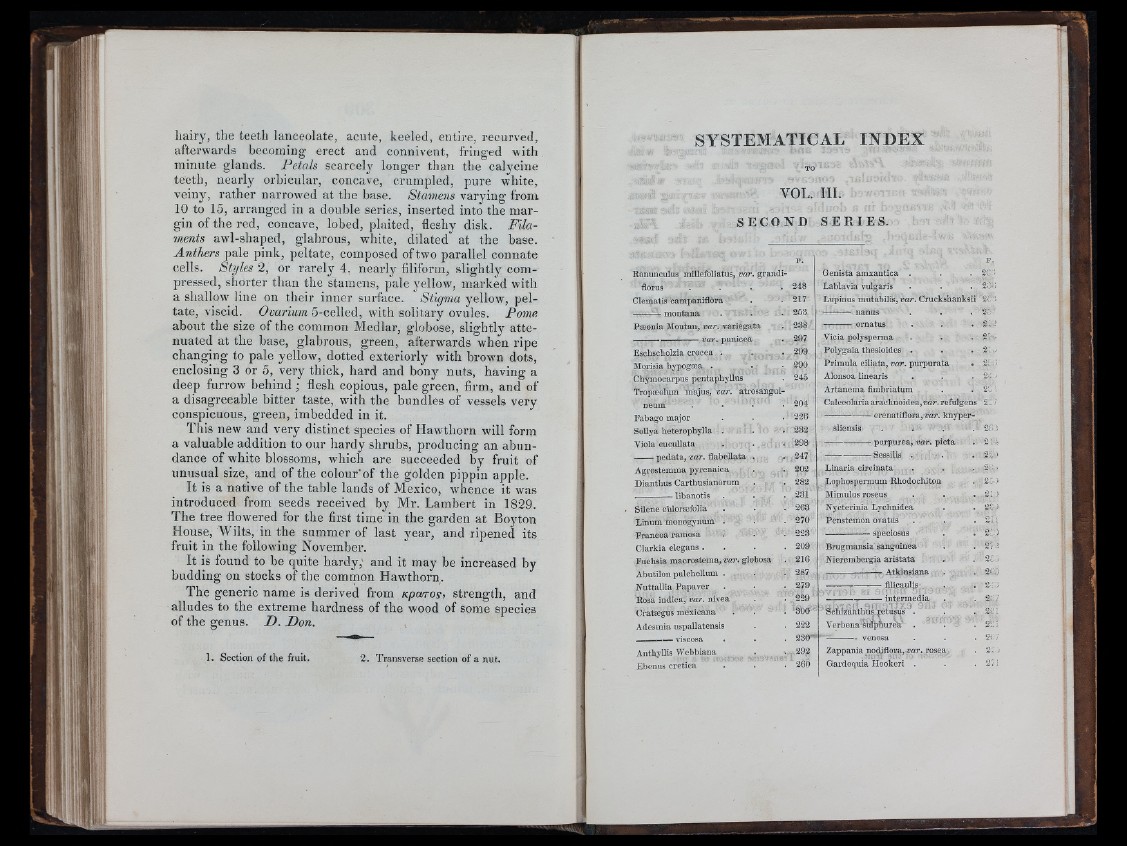
hairy, the teeth lanceolate, acute, keeled, entire, recurved,
afterwards becoming erect and connivent, fringed with
minute glands. Petals scarcely longer than the calycine
teeth, nearly orbicular, concave, crumpled, pure white,
veiny, rather narrowed at the base. Stamens varying from
10 to 15, arranged in a double series, inserted into the margin
of the red, concave, lobed, plaited, fleshy disk. Filaments
awl-shaped, glabrous, white, dilated at the base.
Anthers pale pink, peltate, composed of two parallel connate
cells. Styles 2, or rarely 4. nearly filiform, slightly compressed,
shorter than the stameus, pale yellow, marked with
a shallow line on their inner surface. Stigma yellow, peltate,
viscid. Omrium 5-celled, with solitary ovules. Pome
about the size of the common Medlar, globose, slightly attenuated
at the base, glabrous, green, afterwards when ripe
changing to pale yellow, dotted exteriorly with brown dots,
enclosing 3 or 5, very thick, hard and bony nuts, having a
deep furrow behind ; flesh copious, pale green, firm, and of
a disagreeable bitter taste, with the bundles of vessels very
conspicuous, green, imbedded in it.
This new and very distinct species of Hawthorn will form
a valuable addition to our hardy shrubs, producing an abundance
of white blossoms, which are succeeded by fruit of
unusual size, and of the colour'of the golden pippin apple.
It is a native of the table lands of Mexico, whence it was
introduced from seeds received by Mr. Lambert in 1829.
The tree flowered for the first time in the garden at Boyton
House, Wilts, in the summer of last year, and ripened its
fruit in the following November.
It is found to be quite hardy, and it may be increased by
budding on stocks of the common Hawthorn.
The generic name is derived from uparos, strength, and
alludes to the extreme hardness of the wood of some species
of the genus. D. Don.
1. Section of the fruit. 2. Transverse section of a nut.
SYSTEMATICAL INDEX
TO
VOL. III.
S E C O N D S E R I E S .
p. p.
Ranunculus millefoliatus, var. grandi- Genista amxantica . 2C :
fiorus . . . . 348 Lablavia vulgaris 29' ;
Clematis campaniflòra 317 Lupinus mutabilis, var. Cruckshanksii 2i. ;
---------- monta, na • . ' « 353 iianu"' 25 .■
Peeonia Moutan, var. variegata 238 ---------- ornatus 2 . i
-------------------------var. punicea 397 Vicia polysperma 2: -
Eschscliolzia crocea . 299 Polygala thesioides . 2:./
Morisia hypogsea . 290 Primula ciliata, var. pui*purata •
Chymocarpus pentaphyllus 245 Alonsoa linearis 21 --
Tropeeolum majus, var. atrosanguiArtanema
fimbriatum 25 ■
neum' . . . . 204 Calceolaria arachnoidea, var. refulgens 2~
Fabago major 226 ----------------- crenatiflora, var. knyperSollya
heterophylla . 232 sliensis . . . . 20 Î
Viola cuculiata 298 ------------------purpurea, var. picta 2 IÁ
-------pedata, var. flabellata . 247 ------------------Sessilis . 20 i
Agrostemma pyrenaica 302 Linaria circinata 2-.: ‘
Dianthus Carthusianorum 282 Lophospermum Rhodochiton 2!..)
---------------libanotis 331 Mimulus roseus 2: )
Silene chlorsefolia 263 Nycterinia Lychnidea 2S.Í
Linum monogynum . 270 Penstemon ovatus 2 1 1
Francoa ramosa 223 -----------------speciosus 2: )
Clarkia elegans . . 209 Brugmansia sanguinea 27 3
Fuchsia macrostema, var. globosa . 210 Nierembei’gia aristata 20 ;
Abutilon pulchellum . 387 --------------------- Atkinsiana 2ÚJ
Nuttallia Papaver 279 --------------------- fìlicaulis 2-; ;
Rosa indica, var. nivea 229 ---------- -—^----- intermedia . . 20
Crateegus mexicana 800 Schizàhthüs)çetûsi5^. 20'
Adesmia uspallatensis 222 Verbena liilìA u r èa . . ‘ . 2í; í
.n — — viscosa 230" ----------- venosa . . . 20: ;
Anthyllis Webbiana . ■. 292 Zappania nodiflora, var. rosea 20 .
Ebenus eretica 26Ó Gardoquia Hookeri . 2 / I